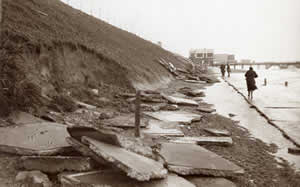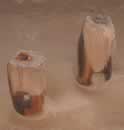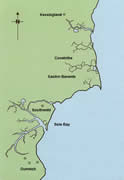| |
If you’d
like to visit Southwold’s neighbour, Dunwich,
you’d better be quick. Every year a little more
of the village falls into the sea – it has lost
eight churches since 1236.
Sole Bay itself was once protected
by two promontories, Easton Ness to the north, and
Dunwich Ness to the south, but both have now disappeared
as the sea eats away roughly a metre of coast every
year.
Although the sea has also swept
fishermen’s huts and boat-sheds away from Southwold’s
beaches, the town has experienced much less erosion
than neighbouring areas – almost entirely because
of the continuing efforts of residents and authorities
to protect the cliffs.
|
|
|
In
1906, just 3 years after the timber sea defences
had been renewed, the cliff path in front of
the Sailors' Reading Room was washed away. A
well shaft was exposed as can be seen clearly
in the enlarged picture. P1642 |
|
|
| |
In
contrast, the village of Easton Bavents was
once a prosperous community with a market, a
fair and churches. By the 17th century the church
of St. Nicholas and most of the houses had been
lost to the sea.
However, one stunning by-product
of the sea’s attacks on Southwold’s
beaches and cliffs is the treasure-trove of
fossils discovered over the years. Eagle-eyed
people have also found deposits of amber (fossilised
resin from plants or trees), jet (the mineral-like
remains of ancient trees) and petrified wood.
In 2006, erosion revealed remains thought to
be of 17th century salt pans. More about fossils
and amber in our storyline: 'In
the beginning'.
Meanwhile the erosion of the
sand cliffs at Easton continues and there is
fear that one day the sea will break through
and sweep in towards the town over the marshes
from the North.
|
|
| |
In
1938 Southwold's sea front was again under
threat when a storm destroyed much of
the promenade.
Click
on the picture for an enlargement.
P699 |
|
|
|
 |
|
|
|
|
|
|
|
|
The
lost Church of Dunwich

The Medieval
church of All Saints in Dunwich was almost
as big as St Edmund's in Southwold. Its ruins
had already begun to tumble into the sea when
this photo was taken in 1904 and, by 1919,
the tower finally fell in. The last traces
of the graveyard behind have only recently
been lost. This part of the coastline is now
officially scheduled for 'managed retreat'
with no plans to protect it.
P077
Click
the picture to enlarge
|
|
|
| |
CHRONIC
GROYNE TROUBLE!

Read
about the efforts, that have been made (with
mixed success) over the years to protect Southwold
from the sea.
Click
here to open a new window. |
|
|
|
|
|
|
|
Whatever
happened to Sole Bay? |
|
|
 |
|
|
|
|
|
|
Click
the map to find out |
|
|
|
|
|
|
|
|